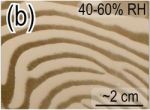EPJ E Highlight - The hidden threat posed by inconspicuous stripes
- Details
- Published on 23 October 2012

Physicists investigate the cause of striped patterns formed by fine particles deposited on surfaces
Patterns fascinate. Particularly stripes. Found in nature in zebras, they are also found in the most unlikely places, such as powdered drugs’ mixing vessel walls. In an article just published in EPJ E, Nirmal Thyagu and his colleagues from Rutgers University, New Jersey, USA, propose a traffic model to predict the formation of different patterns, ranging from stripes to spots.
Thanks to simulations, Thyagu and colleagues showed the underlying stripe formation mechanism, which they propose stems from traffic-like jams, whereby particles move more slowly when surrounded by other particles. This numerical model revealed three distinct patterns of how “sticking” can occur. These include stripe formation, clearing of surfaces between stripes, sharpening lead edges of the stripes, and stripe-to-spot transitions. These results were subsequently confirmed through experiments.
What is more, the authors found, striped patterns invariably form, provided that the relative humidity is in a range between 40 and 60%, and the tumbler surface is sufficiently rough enough to give hold to an initial layer.
Striped patterns formed by particles limit micro-patterned circuit size in electronics, inhaled medicines’ effectiveness and polymer manufacturing efficiency. These patterns also adversely affect pharmaceutical manufacturing, as stripes appear on the walls of mixing vessels used for the production of powdered drugs.
More specifically, the authors also showed that active pharmaceutical ingredients can preferentially stick to mixing vessels’ walls, and can carry as much as twice the concentration of active ingredients. As a result, the bulk powder used for tablets is less concentrated than it should be, or can be too concentrated if the highly concentrated material falls back into the bulk. Research focusing on how the effect carries over when scaling up to pilot- and full-scale manufacturing is currently underway.
Stuck in traffic: patterns of powder adhesion. N. N. Thyagu, A. Vasilenko, A. Voyiadjis, B. J. Glasser, T. Shinbrot (2012), European Physical Journal E 35:105, DOI: 10.1140/epje/i2012-12105-y




